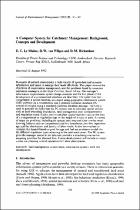JavaScript is disabled for your browser. Some features of this site may not work without it.
- ResearchSpace
- →
- Research Publications/Outputs
- →
- Journal Articles
- →
- View Item
| dc.contributor.author |
Le Maitre, David C

|
|
| dc.contributor.author |
Van Wilgen, BW

|
|
| dc.contributor.author |
Richardson, DM

|
|
| dc.date.accessioned | 2007-06-29T06:02:27Z | |
| dc.date.available | 2007-06-29T06:02:27Z | |
| dc.date.issued | 1993 | |
| dc.identifier.citation | Le Maitre, DC, Van Wilgen, BW and Richardson, DM. 1993. Computer system for catchment management: background, concepts and development. Journal of Environmental Management, vol. 39(2), pp 121-142 | en |
| dc.identifier.issn | 0301-4797 | |
| dc.identifier.uri | http://hdl.handle.net/10204/711 | |
| dc.description | Copyright: 1993 Academic Press Limited | en |
| dc.description.abstract | Managers of natural areas require a wide variety of up-to-date and accurate information and maps to manage their lands effectively. This paper reviews the objectives of conservation management, and the problems faced by mountain catchment managers, in the Cape Province, South Africa. The manager’s information requirements, system design concepts and the first phase of the development of computerised database are described. The system has two concepts: a spatial database developed using geographic information system (GIS) software on a workstation, and a desktop computer database (PC system) developed using a standard relational database package. The GIS is used to generate the links that the PC system uses to associate spatial entities such as land ownership boundaries, land management units (compartments) and vegetation types. It also used to calculate spatial statistics such as the area of a compartment or vegetation type or the length of a road or path, A variety of maps are produced, including an opaque base map and clear overlay maps showing features such as compartment and fire boundaries, post-fire vegetation age and the distribution and density of alien weeds. It also has routines to calculate fire hazard based on post-fire age and fuel accumulation models for the different vegetation types occurring in the catchment areas. The PC system gives the manager access to his data and provides a scheduling routine for assigning priorities for planned fires. Future developments will include an expert system for planning control operations for alien plant species. | en |
| dc.language.iso | en | en |
| dc.publisher | Academic Press Limited | en |
| dc.subject | Land management | en |
| dc.subject | GIS | en |
| dc.subject | Fire management | en |
| dc.subject | Conservation | en |
| dc.subject | Geographic information systems | en |
| dc.title | Computer system for catchment management: background, concepts and development | en |
| dc.type | Article | en |
| dc.identifier.apacitation | Le Maitre, D. C., Van Wilgen, B., & Richardson, D. (1993). Computer system for catchment management: background, concepts and development. http://hdl.handle.net/10204/711 | en_ZA |
| dc.identifier.chicagocitation | Le Maitre, David C, BW Van Wilgen, and DM Richardson "Computer system for catchment management: background, concepts and development." (1993) http://hdl.handle.net/10204/711 | en_ZA |
| dc.identifier.vancouvercitation | Le Maitre DC, Van Wilgen B, Richardson D. Computer system for catchment management: background, concepts and development. 1993; http://hdl.handle.net/10204/711. | en_ZA |
| dc.identifier.ris | TY - Article AU - Le Maitre, David C AU - Van Wilgen, BW AU - Richardson, DM AB - Managers of natural areas require a wide variety of up-to-date and accurate information and maps to manage their lands effectively. This paper reviews the objectives of conservation management, and the problems faced by mountain catchment managers, in the Cape Province, South Africa. The manager’s information requirements, system design concepts and the first phase of the development of computerised database are described. The system has two concepts: a spatial database developed using geographic information system (GIS) software on a workstation, and a desktop computer database (PC system) developed using a standard relational database package. The GIS is used to generate the links that the PC system uses to associate spatial entities such as land ownership boundaries, land management units (compartments) and vegetation types. It also used to calculate spatial statistics such as the area of a compartment or vegetation type or the length of a road or path, A variety of maps are produced, including an opaque base map and clear overlay maps showing features such as compartment and fire boundaries, post-fire vegetation age and the distribution and density of alien weeds. It also has routines to calculate fire hazard based on post-fire age and fuel accumulation models for the different vegetation types occurring in the catchment areas. The PC system gives the manager access to his data and provides a scheduling routine for assigning priorities for planned fires. Future developments will include an expert system for planning control operations for alien plant species. DA - 1993 DB - ResearchSpace DP - CSIR KW - Land management KW - GIS KW - Fire management KW - Conservation KW - Geographic information systems LK - https://researchspace.csir.co.za PY - 1993 SM - 0301-4797 T1 - Computer system for catchment management: background, concepts and development TI - Computer system for catchment management: background, concepts and development UR - http://hdl.handle.net/10204/711 ER - | en_ZA |






